
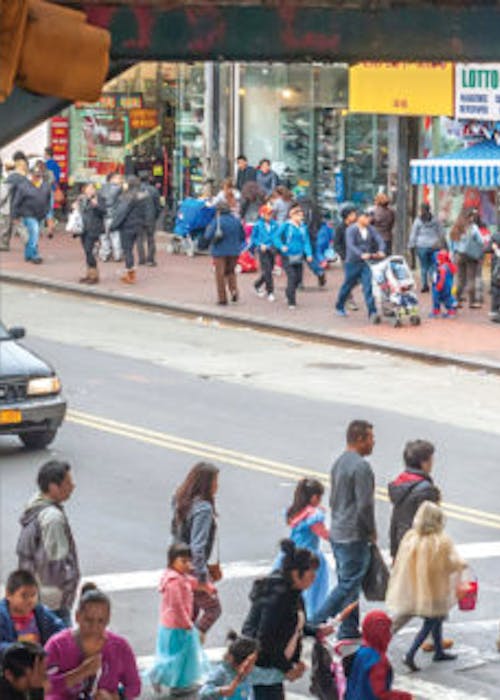
COVID-19 in Elmhurst/Corona, Queens: Why the community’s needs and strengths are more important than ever
Digital Briefs
April 22, 2020
This blog is available in Spanish.
Leer en español >As tragic news unfolded and data became available on the global COVID-19 pandemic, the neighborhoods around Elmhurst/Corona, Queens, broadly and specifically Elmhurst Hospital became the unofficial epicenter of the emergency response to the public health crisis in New York City and arguably in the United States. The highest rates of positive COVID-19 tests have been among patients living in the Elmhurst and Corona ZIP codes.
More than a year before the current crisis, Citizens’ Committee for Children of New York began working collaboratively with residents, community-based organizations, and other partners on a community-based assessment of the most pressing needs of children and their families living in Elmhurst/Corona, Queens. This assessment illuminated many of the factors which have amplified risks to children and families in this pandemic – not just in Elmhurst/Corona, but in communities across New York City.
The community-based assessment revealed how, alongside a rich landscape of family-focused service providers and resources in this vibrant, majority-immigrant community, families face a multitude of challenges: nearly two in three children lived in households in or near poverty; residents were disproportionately working in lower-wage professions; one in four households were overcrowded; many adults lacked health insurance coverage; and the demand for critically important early education, afterschool, and behavioral health programs outstripped supply. The current crisis heightens the urgency to address these needs with solutions we have already elevated from community members – just to name three out of dozens listed in our summative report:
- Ensuring that families experiencing food insecurity have access to nutrition assistance or emergency food programs regardless of federal policy proposals that seek to make it more difficult for families to receive support.
- Safeguarding protections for rent-stabilized tenants and increase funding for rental subsidies for low-income households.
- Promoting efforts that ensure access to affordable health care, including through public choice health insurance plans or public programs that guarantee low-cost or no-cost services at public health care providers and regardless of immigration status.
The full list of solutions and an Executive Summary of the report is also available in Spanish.
We know from our partners in Elmhurst/Corona that the need and effort to put into place these solutions have only grown during this crisis; we are also encouraged to see how many organizations have stepped up to continue serving the community in the current context. Many programs at ElmCor Youth and Adult Activities, Public Health Solutions , and Forestdale’s family services remain open with social distancing measures in place, and provide bolstered, telehealth options for assessments and counseling. The Queens Public Library expanded their digital resources and the New York Hall of Science also compiled a host of free online resources for families to engage in learning and diversion.
These services are so important during this time, and so too is strengthening and investing in resources that address the challenges that families faced prior to COVID-19. The consequences of this crisis are potentially devastating for Elmhurst/Corona and similar communities that were already experiencing higher rates of low-wage work, food insecurity, housing instability, and barriers to accessing health care.
INDUSTRY OF WORKERS
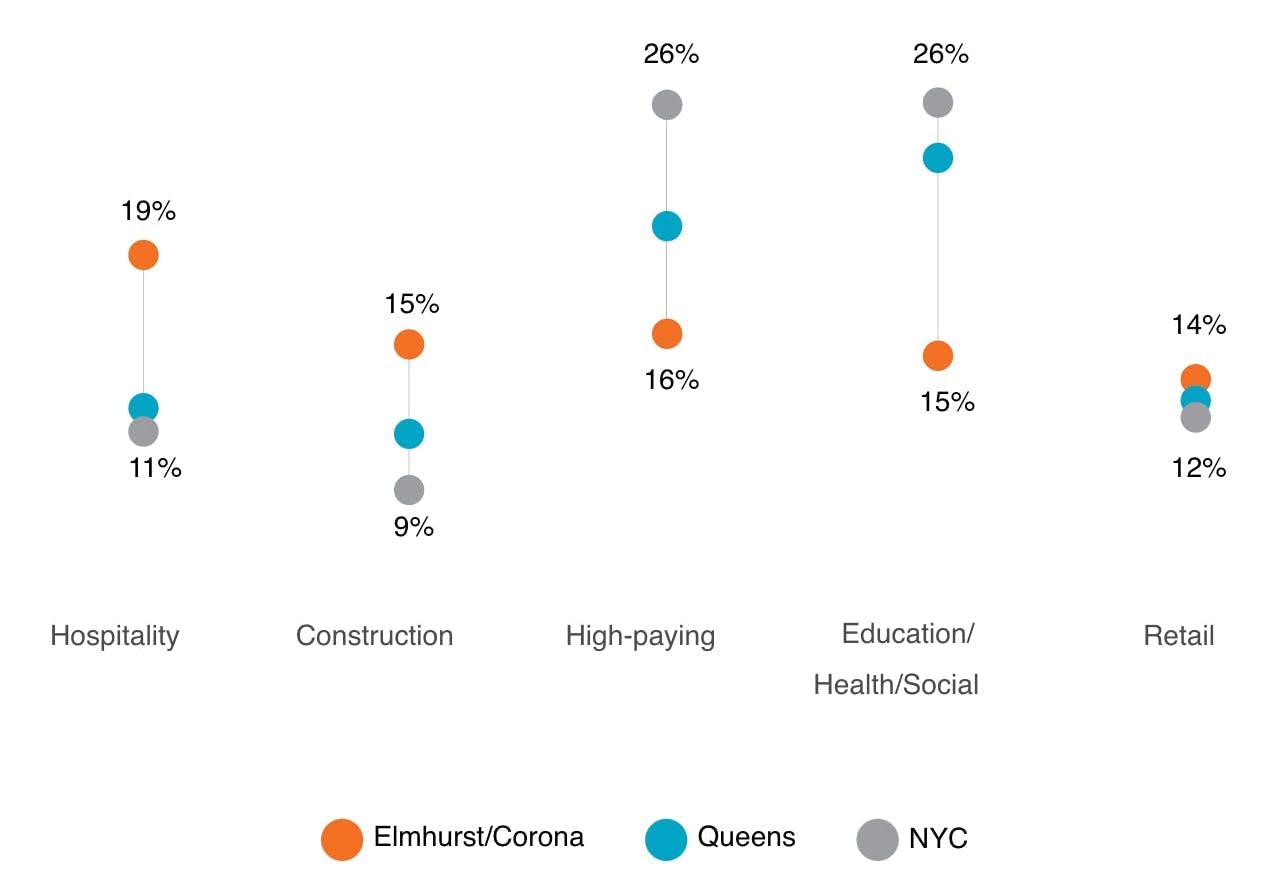
In Elmhurst/Corona, nearly two in three children live in households that are in or near poverty (or below $50,000 for a family of four). Compared to the rest of the city, workers living in the area are disproportionately employed in hospitality services and construction — industries that were already more likely to offer lower wages and minimal benefits, and which may now have lost thousands of jobs under state-mandated lockdown orders.
The current pandemic has the potential to heighten the economic insecurity of many more families in the area than were already in need of support. History tells us that the consequences of an economic downturn may be acutely felt in a working-class community like Elmhurst/Corona: in just five years following the 2007-2008 Global Financial Crisis, the number of households in poverty rose nearly 40% in the district.
With another economic crisis in motion, access to food and income supports are now essential. In parts of Elmhurst/Corona, there is only one large food retail location serving tens of thousands of residents.
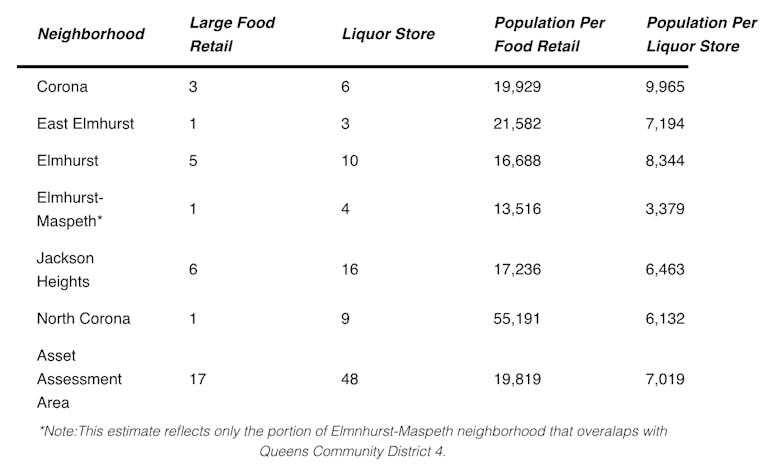
SNAP Coverage by Neighborhood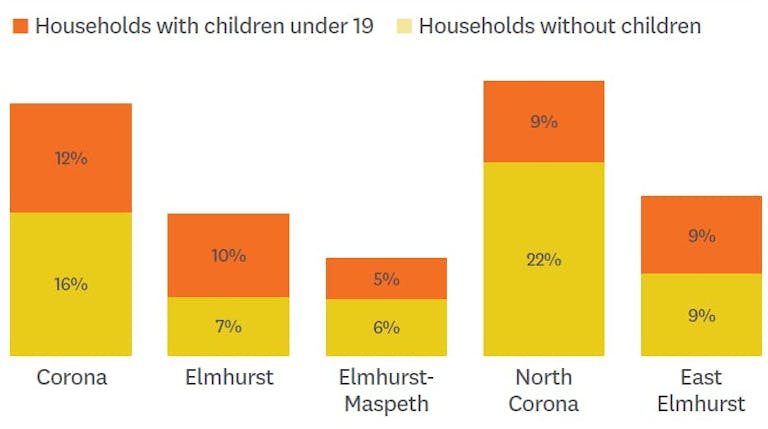
In addition to the demands on an under-resourced food system, food insecurity is also an affordability issue. In areas like Corona and North Corona, more than a quarter of all households are enrolled in the Supplemental Nutrition Assistance Program (SNAP, or Food Stamps). Some community resources providing emergency food assistance have had to close, and enrollment in SNAP and other nutrition assistance programs has moved online or over the phone since in-person appointments are cancelled.
Housing Instability
Housing-related stressors and risks to family well-being were among those most frequently raised in our conversations with residents of Elmhurst/Corona. The district has one of the highest rates of overcrowding – or rental units housing more than one person per room. This has been the case since 2005, and overcrowding is disproportionately high in immigrant communities, including and especially in Elmhurst/Corona and nearby Jackson Heights, Queens.
SHARE OF OVERCROWDED RENTAL HOUSING IN NEW YORK CITY AND COMMUNITIES
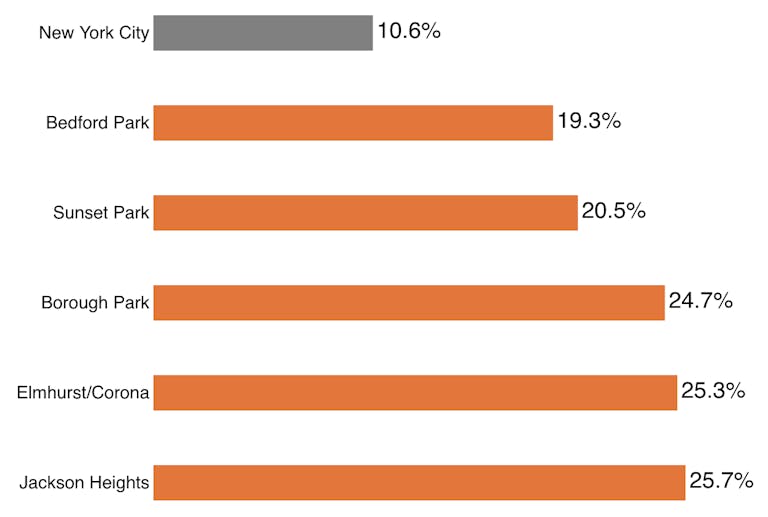
This poses a particular barrier to adhering to social distancing guidelines if a family member is infected at home. Furthermore, high rates of overcrowding underscore the dire need for more affordable housing in the community, especially for the nearly 5,000 students who lack stable housing in the school district – 84% of whom are temporarily living with relatives or neighbors due to economic hardship. These temporarily housed students and more than 100,000 others like them experience unique challenges with remote learning during this crisis, as they may lack access to a reliable internet connection, or a personal device to call their own, or both
Health Vulnerabilities
Access to health care is on the top of mind for many New Yorkers right now. While the city has made strides in expanding access to health insurance, some communities continue to report higher rates of uninsured adults and children, which may be a barrier to seeking health care. In Elmhurst/Corona, there are more uninsured residents than anywhere else in the city – and alarmingly, these numbers saw an increase in 2018.
Uninsured Rates for General Population and Children Under 19
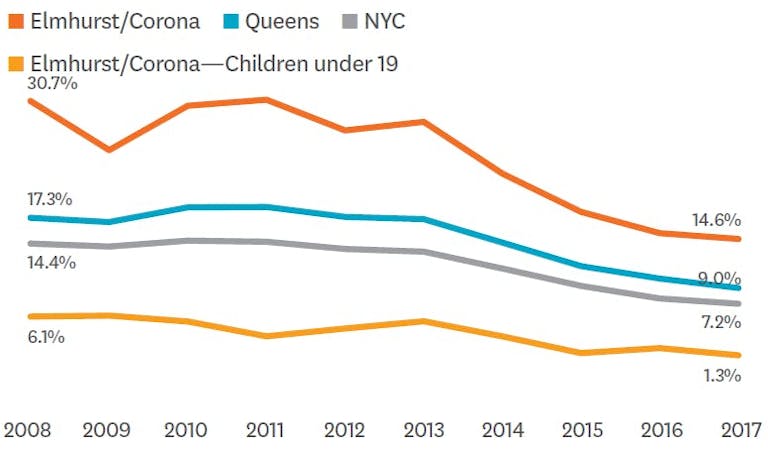
Uninsured by Neighborhood
Neighborhood
Total Uninsured
Uninsured Rate
Elmhurst
12,020
20.2%
Elmhurst
15,754
18.9%
Elmhurst-Maspeth
4,228
16.5%
North Corona
18,343
33.2%
East Elmhurst
3,749
17.7%
Of the uninsured population in Elmhurst/Corona, 88% are foreign-born and 74% are Hispanic/Latinx. In tandem with the concerning findings from CCC’s Keeping Track of New York City’s Children: 2020 (Click here to download the digital book) that Asian children and non-citizen children are disproportionately uninsured citywide, these facts make plain the clear need for culturally and linguistically appropriate outreach and services in immigrant-majority communities – especially in the midst of a public health crisis.
Investments At The Federal, State, And Local Level Are Needed To Support The Needs And Strengths Of Elmhurst/Corona And Similar Communities Facing The COVID-19 Outbreak
The lessons learned from Elmhurst/Corona must shape policy solutions in order to meet the immediate needs of families and children, support frontline health and humans service providers who make up the robust community infrastructure on the ground, and address the mounting crises of economic precarity, housing insecurity, and barriers to health care that not only predated this crisis, but are likely to worsen because of it.
As Elmhurst/Corona has come into the limelight of New York City’s COVID-19 response, it’s critical that we not forget the pre-existing factors that have compounded the crisis – not just in this unique part of Queens, but for a number of neighborhoods in different boroughs. These areas are home to Black, Latino, and immigrant populations, working in hospitality and related service industries, living in overcrowded housing, with higher rates of uninsured adults. Any viable path forward from this moment must take heed of the recommendations from residents of Elmhurst/Corona. These entail significant investments from all levels of government so that families and children can not only stay afloat, but thrive going forward.




